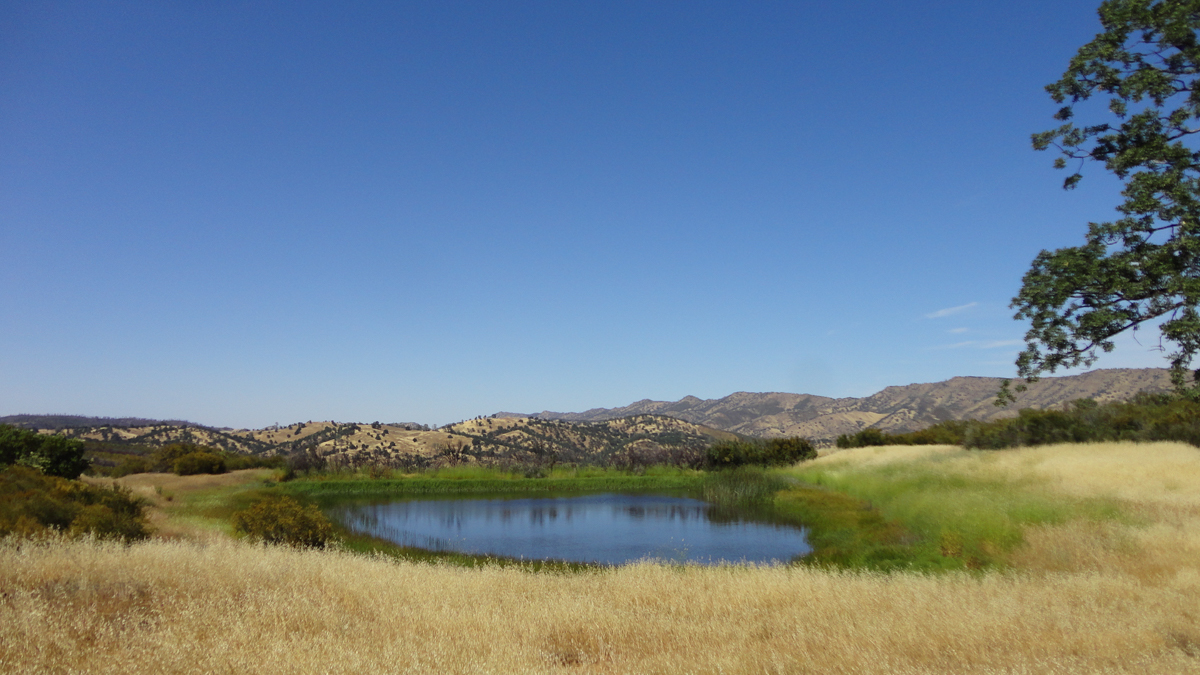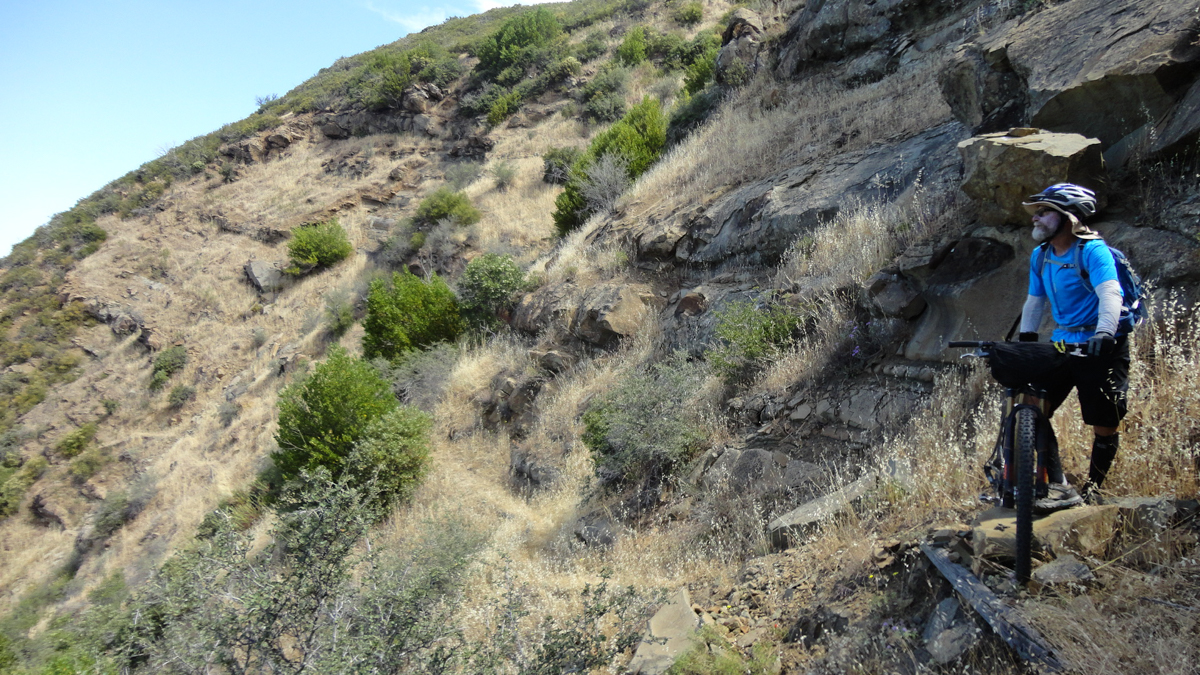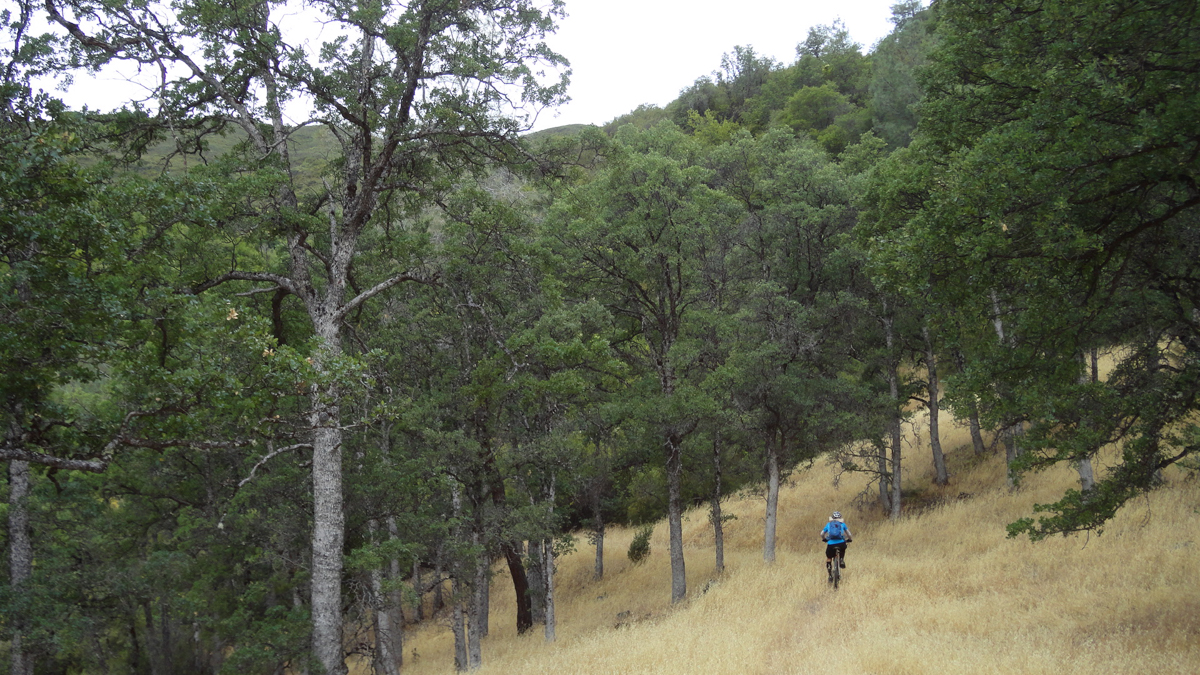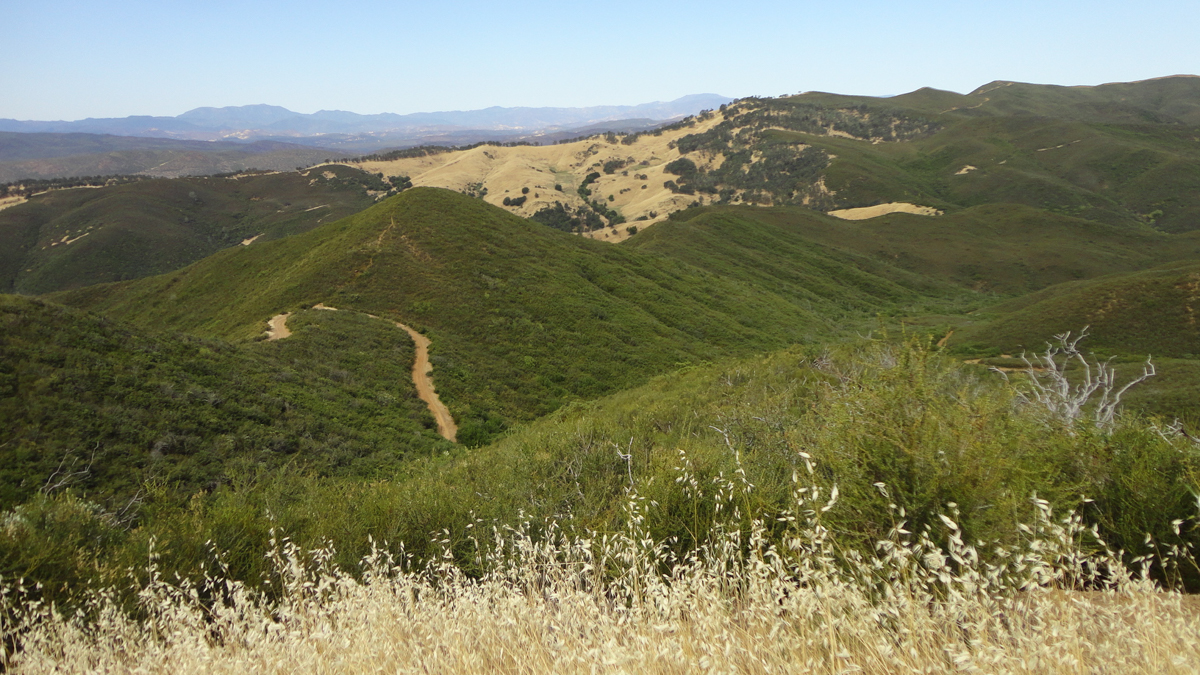Almost Dead: Shattered in the Backcountry
Originally posted on August 17, 2017 at 1:45 amBy James Murren
We woke inside our tents under a cloudy, early morning sky. Knowing we had a hard ride in front of us and unsure of what the trail conditions would be like on this backcountry route, we welcomed the cover from the sun. The Fiske Peak loop, in California’s new Berryessa Snow Mountain National Monument, located just north of Sacramento and the San Francisco Bay Area, was our morning itinerary; it links up County Road 40, Fiske Creek Trail, Fiske Road and Blue Ridge Trail. At 16.5 rugged and remote miles, local beta suggested it would take upward of five hours to complete.
We fueled up with breakfast calories and then went down to Fiske Creek to filter water and fill our bottles and hydration packs. At the creek, we drank some water while pumping, and then pumped additional grimy creek water through the filter back into the bottles to top them off. I had approximately 91 ounces of water and electrolytes and Steve had about 110 ounces of the same.

Time: 7:50 am
Up County Road 40 we went, a slow pedal to ease into the first section of the ride: 800-plus feet of elevation in a little over 2 miles. The pace was not too strenuous, though a few spots required a little extra effort. Not seemingly too long into it, we reached the turnoff for Fiske Creek Trail on the left.
Rolling along through the oak forest with golden grasses as our flooring, we enjoyed the natural beauty surrounding us. For the first 1.5 miles down to the creek, the trail was rideable, though it was a little on the unkempt side. Nevertheless, we were smiling and having a great time.
At the creek, things began to change. Much of the trail was overgrown, though we were able to pedal some sections. Bushwhacking, sidestepping poison oak, pushing and pulling our bikes, and searching for and finding the trail as it crisscrossed a mostly dry creek bed made lifting our bikes over and through rocks our primary activities for 2.5 miles, which took us nearly and hour and a half according to my SPOT satellite messenger unit.
Arriving at Fiske Creek Road, I let out a holler of relief and happiness all in one, glad to be out of that creek bottom. We stopped and rested a bit, eating and drinking before the 2-plus-mile climb up a “four-wheel drive- required” dirt road to the “helipad”—a flat spot some 1,200-plus feet high at the end of the road and below the ridgeline.
Off we went. Both of us being ones who like climbing, we were content pedaling and taking in the views, and to not be hike-a-biking or bushwhacking. A wonderful pullout with a view of Lake Berryessa to the south was a nice reward before we reached the helipad.
We climbed a little more, reaching the flat spot. With 8.5 miles yet to go across Blue Ridge, we had completed half the loop. We ate lunch, sent out some text messages, and I pushed OK on the SPOT, relaying our GPS location.

Time: 10:16 am
To get up on the ridge, we had to push and shoulder our bikes on a barely distinguishable trail. Iron stakes marking it helped us navigate until the goat path became clearer, though not rideable within our set of skills. Finally up top on the backbone of Blue Ridge Trail, we stopped, taking in another grand view.
We snapped some photos and set out for Lowery Peak, the 3,000-plus-foot high point of the trail, which was only a little more than a mile up the ridge. It took us more than 30 minutes to reach it due to more bushwhacking, though this time it was primarily through chamise chaparral. On occasion, we pedaled, inflicting pain upon ourselves as the scrubby plants thrashed our arms and legs.
A few cleared-out sections on the rocky faces we rode with ease—having a blast on a few of the technical spots. Then, from Lowery to Fiske Peak the trail undulated up and down the ridge and became mostly overgrown again, requiring more hike-a-biking.
Along the way, we stopped to take a break, and I noticed that my urine was a little dark. I told myself that it was not as dark as when I had malaria. I just need to drink more, I thought.
Eventually, the trail opened up. From Fiske Peak going south, local hikers maintain the trail, making for a great mountain biking experience. Despite the prime trail conditions, I was getting very tired. Additionally, I was becoming short of breath. Several times I had to stop and walk my bike. “Why can’t I breathe?” I asked myself.
Pushing on, we finally got to Fiske Peak: 3.5 miles from Lowery Point. I looked around for a few minutes at the view and then started down. I wanted to be done. Steve took a few photos as I looked for the trail off the peak. Steve noticed where it was and pointed me in the right direction.
Only 2.5 miles downhill to go, I told myself.

Not five minutes in, we stopped to chat with two hikers on their way up to the peak. Pleasantries exchanged, we continued down. It was steep with tight switchbacks. We rode some of them and then started walking a lot of them. The trail was a little overgrown, adding to the challenge. Rocks soon entered the scene. Incredulously, we were hike-a-biking again, over and around and through rocks and steep, washed-out switchbacks.
I was not doing well. I was still short of breath; my muscles began to twitch. I could not recall ever before feeling my forearm muscles in a state of spasm. Steve was up ahead, and I was slowing down.
Thankfully, he stopped to wait for me more than once. When I told him that I still was having trouble breathing, he suggested that I walk and that he would ride ahead, walk back up the trail, get my bike and ride it back down as I walked.
I didn’t hesitate on his offer. Two back-and- forths later, and after I climbed up and over a 4-foot high rocky section, I was done.
“Steve, I need to sit down.”
“OK, no problem.”
I sat on the trail. My heart was racing. Suddenly, I began to excessively sweat. “What is going on?” I thought in silence.
I spotted a rock, smooth on its face, that had a perfect angle to lie back on.
After getting both bikes over the rocks, Steve stepped up the trail toward where I was lying. I had trouble focusing my eyes, my vision slightly blurry.
I began to get scared.
“Do I push the button?”
Steve hesitated. I mentioned again about my breathing troubles and that my heart was racing and that I felt like I couldn’t move, even if I tried. I was incapacitated and out of water. Steve had a few swallows left.
“Yeah, maybe so.”
It was my decision to make; I knew that. I thought of dehydration and how quickly it can kill you. I looked at the SPOT device. I felt that I had greater than a 50-50 chance of not making it out. I lifted the black rubbery flap marked S.O.S.
I pushed the red button.

Time: 2:41 pm
First thought: My wife, parents and siblings are going to be very worried. I felt terrible knowing that.
Steve stood over me, blocking the sun. Dehydration was wrecking my body. I was pissed off, somewhat embarrassed but more than anything else, scared.
I couldn’t move. I was debilitated. I asked Steve to gather all the bottles and empty any remaining residual fluids into one. He quickly did it. Between the bottles and the final drops left in his hydration pack, I got about 3 to 4 ounces of water in me.
Radiating out from my core, my arms and legs went numb, though not entirely numb. It wasn’t tingles either, and not exactly like when a leg or foot falls asleep. It was a slow, gradual, spreading effect.
Is this what happens when your body begins to shut down? Feel less pain?
“Steve, I’m so sorry. This is not good. My body is going numb.”
Silence. “Please tell my wife that I love her, and that I’m sorry. I’m so sorry.” I didn’t know if this was it, as in … the beginning of the end.
Numbed body. Blurred vision.
“Remember, a lot of who we are is in our minds. Keep a strong mind,” Steve spoke with calmness.
“I might die on a trail in California.”
Keep a strong mind, I quickly reminded myself. Breathe. Relax.
The numbness subsided a little. Breathe.
We assessed that the hikers would have to come back down, that they would likely have some extra water and that Steve waiting with me was letting valuable time pass—that it was time for him to go get water at the creek where we started in the morning.
I tried to move to a shadier spot. My quads immediately seized and I screamed in pain. “I’ve never had my quads cramp,” I said to Steve. Sitting there on the ground, I shook and rubbed them out.
About 35 minutes after I pushed the button, Steve grabbed his bike and headed down the trail.
Alone, I sat and listened to the forest. I was not sweating and didn’t feel cold, though I was a little chilly when the breeze kicked up. It was a perfect afternoon in the mountains: warm sunshine, not humid, temperature somewhere in the low 80s. No fever was present, nor anything like heat exhaustion chills.
Birds sang songs and insects buzzed as leaves fluttered. I listened for the hikers’ voices. I tried to rest my mind, stopping it from thinking about my situation: unable to move, debilitated, less than 1.5 miles from the end of the ride, knowing a creek was down there, and hearing an occasional car pass by on the road that hugged the creek.
I looked at my watch and told myself that if Steve or the hikers didn’t arrive by 5 p.m., I had to make a move. What if Steve crashed? What if the hikers know another way down or are staying up there for the afternoon?
Breathe. Relax. Do not fall asleep.
Sometime around 4 p.m. I heard someone yelling my name. It was Steve. I yelled back, “Steeeeeeve.” I waited and didn’t hear a response. I yelled again, “Steeeeeeve.”
Maybe 10 minutes later, I thought I heard voices. “The hikers are coming,” I said aloud to the trees. Slowly, the voices got closer to me. I was relieved.
As they approached the 4-foot climb over the rocks, I let them know I was lying on the trail, to not be alarmed, that I needed any water they might be able to give me.
A father and daughter. She got out her full bottle and gave me half. Next thing I knew, Steve arrived with two bottles of water. All at once, help arrived and I knew that I’d be OK.
I reached for my SPOT to turn it off.

Time: 4:25 pm
The hikers got on their way. I sat and drank electrolytes. Steve informed me that he left his bike at bottom and ran back up the trail; in less than an hour, he rode down, filtered water and got back up, completing a 3-mile life-saving trip.
Thwack. Thwack. Thwack.
The emergency helicopter was within earshot. Then we saw it as it passed by us and continued up the canyon. It turned around and came back through. We stood in a clearing and waved it off, motioning for it to pass us by and gave a thumbs-up that we were OK.
I felt terrible for having them do that.
We started the walk down. I could not believe it. Less than a few hundred feet from where I was lying and unable to move, the trail cleared out and was a smooth ribbon of beautiful singletrack all the way to the end.

Time: Approximately 5:45 pm
At my car I sent a text to my wife and family that we were OK and that I would call later. I became overwhelmed with emotions and tears streamed down my face.
Back down at the creek, Steve and I packed up camp, loaded the car and went to town to get a hotel room and have dinner.
Later on … after showers and phone calls … we ordered food and sat in the booth waiting for it to come.
“I think I need to lie down.”
“Go ahead,” Steve replied, looking at the floor.
More or less, the next thing I knew, Steve was standing next me, holding me up, saying “Come on, Jim. Come on.” I tasted vomit.
I passed out for three or four seconds while puking up a little water and a chia seed packet that I ate when I first got back to the car.
Wait staff went into motion, and in what seemed to me as being a matter of minutes, the emergency medical team from the local clinic was coming in the emergency exit of the restaurant.
They asked me questions. I answered them all: I was coherent, lucid and not delirious at all.
They took my vitals. All seemed OK and within normal range: Heart rate was up in the 80s but came down into the 70s; blood sugar and electrolytes were good.
“May I get an IV?” I asked.
“You wanna do it here?” the guy in charge responded. “In the booth?”
One of the guys went and got a 1,000 cc IV bag out of the ambulance and came back to my table. Steve slid around the booth and sat next to me in case I passed out and fell to my right. On my left arm, the needle poked in.
While squeezing the fluid into my vein, we had a conversation about mountain biking, different trails around the country, my malaria experience, and yes, it was me who called in the emergency helicopter.
Strangely, while I was getting the IV, people were still in the restaurant eating, carrying on with their meals as if the entire scene was not happening. IV bag emptied, the emergency technicians packed up and said that if I vomited again, we were to call them immediately and that they would take me to the hospital.
Middle of the night, from around midnight through 2 a.m. I got up every 20-30 minutes to urinate. I was clear every time thanks to the IV. I also nibbled at grilled chicken and green salad and took a bite or two of pizza from time to time.
Morning came and I was tired but wanted to get home. By 8:30 a.m. we were on the road. That evening, before the sky was dark, I was holding my wife like never before.

Postscript
The more I thought about it, the more I questioned what really happened to me. How did I dehydrate in five hours while drinking around 120 ounces of electrolytes and water? We started out in the morning under cloud cover, temperatures likely in the low 60s and never going above the low 80s. I never felt hot, never got chills or goose bumps that are characteristic of heat exhaustion. I did not have a headache nor feel any nausea.
Wednesday morning:
I go to the doctor and explain everything you read here. His assessment: Sure, I likely was dehydrated, but not severely dehydrated. He was more concerned about my difficulty with breathing. He wanted me to see the cardiologist. Also, I had to get urine and blood tests.
Thursday morning:
Blood drawn and urine sample completed.
Weekend:
Under doctor’s orders, I did not exercise and continuously kept hydrated. No alcohol of any kind.
Monday:
Lab results come back. My AST and ALT (liver enzymes) numbers are high, especially AST, which is more than two times higher than the high end of normal range. That means muscle damage. Also, my CPK (muscle enzyme) is more than fives times higher than the high side of normal. Again, muscle damage is evident.
New lab work is ordered for the following week to see if the numbers come down. I’m still under strict orders to rehydrate, take it easy, and refrain from exercise and alcohol.
Thursday:
The cardiologist hears the story, learns of my blood lab results, looks at the electrocardiogram, which depicts a normal healthy, athletic heart and says, “You had rhabdomyolysis.”
“What? Can you write that down for me?”
Rhabdomyolysis.
He went on to say that my body was shutting down, that it was telling me to stop moving and that it was good that I stopped before it got any worse. He added, “When rhabdo sets in, you can reach a point where physically you feel like you are unable to move and it seems to happen out of nowhere.”
Two weeks later:
A new round of blood tests resulted in everything being back to normal. Echocardiogram showed a healthy heart. I was “me” again, with no indication of residual muscle damage, and my liver and kidneys are fine.
I was back on the bike and feeling “normal.”

Rhabdomyolysis
If, like me until this happened, you’ve not heard of it, take some time to research and learn more. Thus far, as of this writing, I’ve talked with mountain bikers, personal trainers, hikers, mountaineers, runners … and none of them had heard of it.
As a mountain biker, you want to know what rhabdomyolysis is. In the CrossFit world, they call it “Uncle Rhabdo.” It’s no joke, though. This seems certain: If your urine ever has a hue of orange, strawberry, pale red or slight brown to tea-color, you could be experiencing rhabdomyolysis, aka rhabdo.
What’s the concern? Rhabdo occurs when your muscles are damaged and myoglobin, a protein found in your muscle tissue, enters your blood circulation. The problem is that your kidneys can’t deal with it, most especially if you are not optimally hydrated, e.g., mountain biking and rationing water intake on a remote ride.
The worst that could happen is renal failure. Your kidneys are overwhelmed with myoglobin, they fail and you die if it’s not treated.
However, that is not likely, especially if you get hydrated, which should involve an IV or 10. Yep, I’ve read accounts of people who experienced rhabdo and were hospitalized for weeks, getting tens of rounds of IVs. Also, even if you are fairly well-hydrated, rhabdo can happen and it will require additional fluids.
Symptoms:
This is the scary part. There really isn’t anything specific (from what I can tell), other than urine color, and rhabdo can happen out of nowhere. I can attest to that.

Final Thoughts
There is no doubt that the water given to me by the hikers and Steve was instrumental in staving off any more serious conditions. The IV was clutch too. It was the beginning of flushing myoglobin out of my kidneys. I am beyond grateful and thankful to everyone who got me through it. The restaurant puke was likely caused by taking in too much water and my stomach reacting to it.
Do different:
It didn’t help that I did this ride with a heavier bike, a fat bike. All the hike-a-biking and bushwhacking and carrying it over rocks led to overexertion of my muscles. That’s on me, not the bike. Previous trips and rides led me to believe that I’d be fine with a heavier bike. I likely will think that through a little more for the next trip. Also, down at Fiske Creek, we passed two pools of water. Next time, when I see water on a remote ride, I will stop and drink more, and then filter and fill up.
